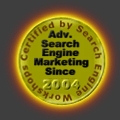 Look how old this is!
Look how old this is! I post at SearchCommander.com now, and this post was published 18 years 4 months 20 days ago. This industry changes FAST, so blindly following the advice here *may not* be a good idea! If you're at all unsure, feel free to hit me up on Twitter and ask.
Want to make a crappy Content Management System that nobody will want to use?
Let me tell you some basic steps that you cannot skip if you want to be in the running for the worst possible product for your users…
- Do not use anything “open source”, where outside developers, programmers or a community can contribute improvements for the system. Everything must be completely proprietary, and prohibitively expensive too.
- Make sure that there are no online help files, or support section at your company website. If you make your own help files, do not allow for any interactivity directly with the user interface. To include that would simply not be crappy enough.
- Be sure to ignore the basic function of any content management system, which is to manage content in an organized manner. Give users only one option, maybe… something like “inventory” for example, to be used for managing all their different content groups needed, such as events, products, downloads or articles.
- Do not include features commonly associated with many other systems, like a blog. Blogs are just a fad, and can be made for free elsewhere, like at Blogger.com. There’s no reason a crappy CMS should have a blog.
- Do not include the ability to display outside RSS feeds on your pages. This gives users too much control over their content, and they might want to display their blog (hosted elsewhere), or other various RSS feeds throughout their site, freshening their static content automatically. This may lead to undesired traffic increases and increased bandwidth use at your hosting facility.
- Do not integrate and auto-generate the 2006 standardized XML sitemap protocol, and if you do, be sure to Google by needlessly pinging them with every site addition. This forces Google to use their resources to crawl your website sooner than they otherwise would on their own schedule.
- There is no need for you to generate your own RSS feeds either. Since there’s no blog anyway, and all the articles, news, events, and products are just “inventory items” there’s not going to be any subscribers that stick around. This also has the added benefit of ensuring that your customers can’t generate a “community” of any kind, or do any of that soon to be fading “Web 2.0” stuff.
- Don’t let your users work under the hood either. By eliminating even the most basic .html view in your extremely slow wysiwyg interface, you can prevent people from mucking around, and doing stupid things… like trying to display their blog RSS.
- Be sure no safeguards are in place for content protection. Some of those “free” CMS systems have the ability to see exactly who else is logged on, and exactly what they’re working on, and even show “Locked” if you try to edit their file. do not show this information to your users, because it’s not your time being wasted, it’s theirs.
- Do not provide an efficient or direct file interface for advanced users. Dumb it down completely so that every action or upload is greeted with a popup message telling users whether what they just did actually really happened or not.
- Be sure to randomly fail on routine operations, so users do not become complacent and stop reading your popup messages, or try to figure out how to turn them off. This keeps users dependent on any support program you may offer for a fee.
- Don’t allow users to continue working immediately after entering their data. Make them have to manually close, or wait at least 10 seconds for “this window will automatically close” to happen. Forcing that “wait” window to popup behind the actual working window is not an option to be considered.
- Make sure that any events all have expiration dates, and that they will automatically disappear from your website, with no built in options for server redirects. This ensures that any search results or inbound links accumulated will lead right to a 404 error page.
- If you take credit cards, be sure that the money does not process to your account automatically. No “hands off” bookkeeping should be implemented. Instead, force customers not to just “set it and forget it” by logging in daily to get their money.
- Since the web hosting for your crappy CMS will be done only on your own servers, make sure you don’t give your clients simple email hosting. Force them to deal with a third party, and have their IT departments figure out their A record and MX record DNS stuff.
- Don’t create “auto-generating” unique title and description tags derived from the users input of that particular inventory item, event or article. Force them to go to another field in a separate tab, effectively doubling the time needed to make content additions.
- Be sure not to generate search friendly page names. Use many random characters for your inventory items that have nothing to do with the product. Wherever you do use actual words in the URL’s, do not follow common SEO best practices. Matt Cutts announced over a year ago that dashes were definitely better than underscores, and explained why too, so only use underscores and capital letters wherever possible.
- Finally, be certain to retain a marketing and sales force that are not in direct communication with the developers, and whom have not used the product for themselves. This is crucial for their culpability while making marketing claims about functions you cannot deliver.
This is a generic opinion piece, and any similarity to your particular Content Management System, is purely coincidental. The views expressed here are purely mine alone.
Feel free to add your own comments and suggestions that might make the use of any CMS system further intolerable…




















Hi there, I’d be interested in hearing how you think our open source CMS, SilverStripe stacks up against your critera.
A demo is available here
Good article. Some more points:
Don’t give people the ability to intuitively learn the system by filling the product up with hundreds of features, all designed to be quickly coded rather than intuitively used. Ensure that only the core development team of the CMS is fluent in using the system because of its complexity. (Wow, I sure hope that Nokia, Sony Ericcson et al like their phones, because no one else appreciates the features…)
Also, make sure the process of performing common tasks, like adding a new page (a news article, a new staff member) must be no easier than rarely performed tasks because you’ve been so busy learning PHP that concepts like Interaction Design have yet to be understood.
Whatever you do, don’t break your paragraphs to make it readable.
@hop – point well taken – fixed 😉